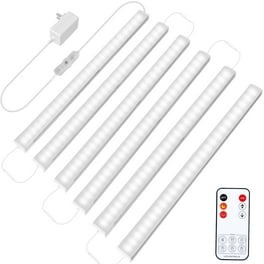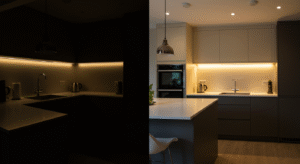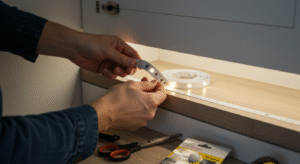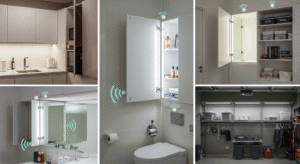Top Amazon Brands for Motion Sensor Cabinet Lights To Consider
- EZVALO 5 Pack Under Cabinet Lighting, Rechargeable Motion Sensor Light
- BLS LED Closet Light, T401 Super Bright Wireless Under Cabinet Motion Sensor Light
- AIBOO Under Cabinet Lighting, Dimmable 12 inch Under Counter Lights
- EShine Hand Wave Activated Under Cabinet LED Lighting
- LEPOTEC Under Cabinet Motion Sensor Light
You’re rushing to grab your morning coffee, stumble into the kitchen half-awake, and… nothing. Your once-reliable motion sensor LED cabinet lights that used to illuminate your workspace like magic are now as responsive as a teenager asked to do chores. Sound familiar?
If you’ve found yourself waving frantically at supposedly “smart” lights or questioning whether you’ve somehow become invisible to your own kitchen fixtures, you’re not alone. Motion sensor LED cabinet lights have become the unsung heroes of modern kitchens, but when they fail, they can turn your culinary sanctuary into a frustrating guessing game.
Today, we’re diving deep into the mystery of why these convenient lighting solutions seem to have a mind of their own—and more importantly, how to get them back on track.
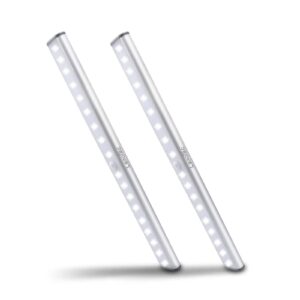
The Anatomy of Motion Sensor LED Cabinet Light Failure
Before we can solve the problem, we need to understand what we’re dealing with. Motion sensor LED cabinet lights are marvels of modern convenience, combining energy-efficient LED technology with infrared motion detection. When working properly, they create an almost magical experience—you approach, they illuminate, you leave, they fade away.
But this seemingly simple process involves several components working in perfect harmony: the motion sensor itself, the LED array, the power management system, and the control circuitry. When any of these elements falters, your lights can exhibit behaviors ranging from mildly annoying to completely non-functional.
The Most Common Culprits Behind Motion Sensor LED Light Failures
1. Power Supply Problems: The Silent Killer
One of the most overlooked causes of motion sensor LED cabinet light failure is an inconsistent power supply. These lights are often battery-powered or connected to low-voltage systems that can be surprisingly finicky.
Battery-powered units suffer from what I call “power fade syndrome.” As batteries drain, the motion sensor becomes less sensitive, creating dead zones where movement isn’t detected. You might notice your lights working perfectly in the morning but becoming sluggish by evening.
Hardwired systems face different challenges. Voltage drops, loose connections, or inadequate power supplies can cause erratic behavior. If your lights flicker, dim unexpectedly, or only work intermittently, power issues are likely the culprit.
2. Motion Sensor Sensitivity: The Goldilocks Problem
Motion sensors need to be “just right”—not too sensitive, not too insensitive. Most people don’t realize that these sensors can be affected by temperature changes, electromagnetic interference, and even the color of your clothing.
During summer months, when the ambient temperature rises, PIR (Passive Infrared) sensors may become less effective at detecting the heat differential from your body. Conversely, in winter, wearing bulky clothing can reduce the heat signature the sensor relies on for detection.
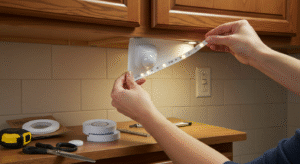
3. Dust and Debris: The Invisible Enemy
Here’s something most people never consider: motion sensors are essentially sophisticated cameras that “see” infrared radiation. When dust, grease, or cooking residue accumulates on the sensor lens, it’s like trying to see through dirty glasses.
Kitchen environments are particularly harsh on these devices. Cooking vapors, steam, and airborne particles can create a film over the sensor that gradually reduces its effectiveness. This often happens so slowly that you don’t notice until the sensor stops working entirely.
4. Installation Issues: Getting the Basics Wrong
Even the best motion sensor LED cabinet lights will fail if they’re not installed properly. Common installation mistakes include:
- Incorrect mounting height: Too high, and the sensor can’t detect movement below; too low, and it becomes oversensitive to minor movements
- Poor angle positioning: Motion sensors typically work best when movement crosses their field of view rather than moving directly toward or away from them
- Interference from other light sources: Nearby fluorescent lights, LED strips, or even sunlight can interfere with sensor operation
5. Quality and Manufacturing Defects
Let’s be honest—not all motion sensor LED cabinet lights are created equal. The market is flooded with budget options that prioritize low cost over reliability. These units often suffer from:
- Cheap motion sensors with narrow detection ranges
- Poor quality LEDs that degrade quickly
- Inadequate weatherproofing that allows moisture infiltration
- Flimsy construction that can’t withstand normal kitchen use
Top Amazon Brands for Motion Sensor Cabinet Lights To Consider
- EZVALO 5 Pack Under Cabinet Lighting, Rechargeable Motion Sensor Light
- BLS LED Closet Light, T401 Super Bright Wireless Under Cabinet Motion Sensor Light
- AIBOO Under Cabinet Lighting, Dimmable 12 inch Under Counter Lights
- EShine Hand Wave Activated Under Cabinet LED Lighting
- LEPOTEC Under Cabinet Motion Sensor Light
Troubleshooting Your Motion Sensor LED Cabinet Lights
Start with the Basics
Before diving into complex solutions, check these fundamental issues:
- Test the power source: Replace batteries or check electrical connections
- Clean the sensor lens: Use a soft, dry cloth to remove any buildup
- Verify the switch position: Ensure the unit is actually turned on (it happens more than you’d think!)
Advanced Diagnostics
If basic troubleshooting doesn’t work, try these more detailed approaches:
Check the detection range: Most motion sensors have adjustable sensitivity settings. Experiment with different levels to find the sweet spot for your installation.
Test at different times: Motion sensor effectiveness can vary with ambient light conditions. Some units perform differently in bright daylight versus dim evening conditions.
Look for interference sources: Temporarily remove or turn off other electronic devices near the lights to see if interference is causing the problem.
Prevention: Keeping Your Lights Working Long-Term
The best fix is prevention. Here’s how to maximize the lifespan and reliability of your motion sensor LED cabinet lights:
Regular maintenance is crucial. Clean the sensor lens monthly and check battery levels quarterly. For hardwired units, inspect connections annually and look for signs of corrosion or loose wires.
Environmental considerations matter too. If your kitchen produces a lot of steam or cooking vapors, consider units with better sealing ratings. Position lights away from direct exposure to heat sources like stovetops.
Quality matters. While budget options might seem attractive, investing in well-reviewed, name-brand motion sensor LED cabinet lights often pays off in reliability and longevity.
When to Replace vs. Repair
Sometimes, despite your best efforts, motion sensor LED cabinet lights simply reach the end of their useful life. Here are signs it’s time to move on:
- Frequent false triggering that can’t be adjusted away
- LEDs that have dimmed significantly or show color shifting
- Motion sensors that work only sporadically despite cleaning and maintenance
- Physical damage to the housing or mounting system
Your motion sensor LED cabinet lights don’t have to be a source of constant irritation. Understanding why they fail—and how to prevent those failures—can restore the convenience and magic these devices are meant to provide. From simple cleaning routines to proper installation techniques, small investments in maintenance and quality can yield big returns in reliability.
Ready to upgrade your kitchen lighting game and say goodbye to those frustrating dark moments? Check out the highly-rated motion sensor LED cabinet lights available on Amazon through Best Buy’s selection. With verified reviews, quality assurance, and the convenience of prime delivery, you can find reliable solutions that will keep your kitchen illuminated exactly when you need it most. Don’t let another morning coffee run become a stumbling adventure in the dark—your perfect kitchen lighting solution is just a click away.
Top Amazon Brands for Motion Sensor Cabinet Lights To Consider
- EZVALO 5 Pack Under Cabinet Lighting, Rechargeable Motion Sensor Light
- BLS LED Closet Light, T401 Super Bright Wireless Under Cabinet Motion Sensor Light
- AIBOO Under Cabinet Lighting, Dimmable 12 inch Under Counter Lights
- EShine Hand Wave Activated Under Cabinet LED Lighting
- LEPOTEC Under Cabinet Motion Sensor Light



